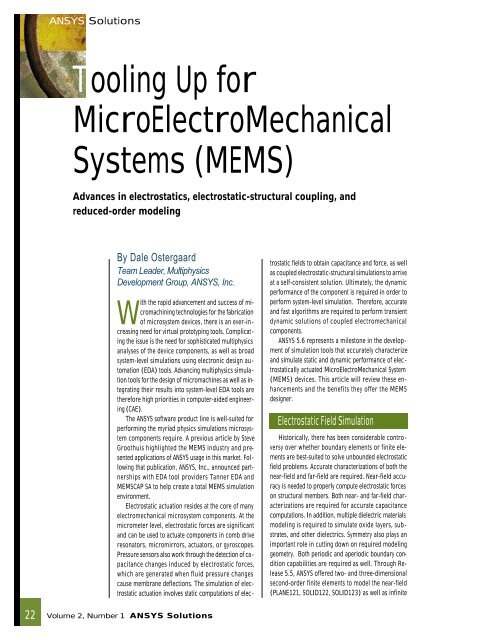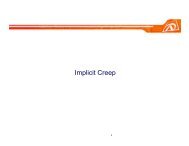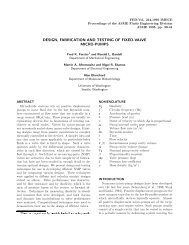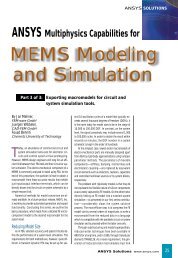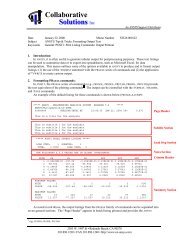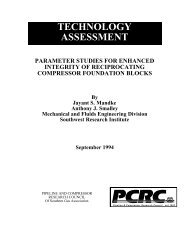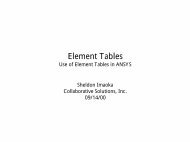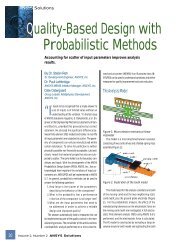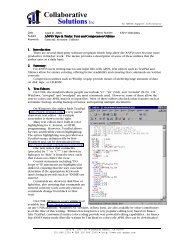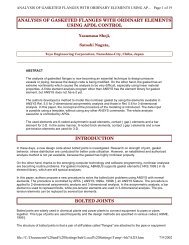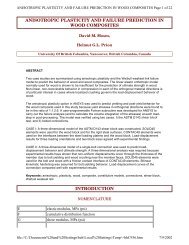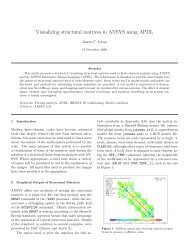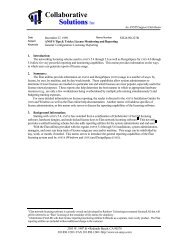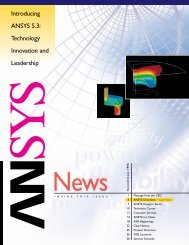MEMS - ANSYS Users
MEMS - ANSYS Users
MEMS - ANSYS Users
You also want an ePaper? Increase the reach of your titles
YUMPU automatically turns print PDFs into web optimized ePapers that Google loves.
<strong>ANSYS</strong> Solutions<br />
Tooling Up for<br />
MicroElectroMechanical<br />
Systems (<strong>MEMS</strong>)<br />
Advances in electrostatics, electrostatic-structural coupling, and<br />
reduced-order modeling<br />
By Dale Ostergaard<br />
Team Leader, Multiphysics<br />
Development Group, <strong>ANSYS</strong>, Inc.<br />
With the rapid advancement and success of micromachining<br />
technologies for the fabrication<br />
of microsystem devices, there is an ever-increasing<br />
need for virtual prototyping tools. Complicating<br />
the issue is the need for sophisticated multiphysics<br />
analyses of the device components, as well as broad<br />
system-level simulations using electronic design automation<br />
(EDA) tools. Advancing multiphysics simulation<br />
tools for the design of micromachines as well as integrating<br />
their results into system-level EDA tools are<br />
therefore high priorities in computer-aided engineering<br />
(CAE).<br />
The <strong>ANSYS</strong> software product line is well-suited for<br />
performing the myriad physics simulations microsystem<br />
components require. A previous article by Steve<br />
Groothuis highlighted the <strong>MEMS</strong> industry and presented<br />
applications of <strong>ANSYS</strong> usage in this market. Following<br />
that publication, <strong>ANSYS</strong>, Inc., announced partnerships<br />
with EDA tool providers Tanner EDA and<br />
<strong>MEMS</strong>CAP SA to help create a total <strong>MEMS</strong> simulation<br />
environment.<br />
Electrostatic actuation resides at the core of many<br />
electromechanical microsystem components. At the<br />
micrometer level, electrostatic forces are significant<br />
and can be used to actuate components in comb drive<br />
resonators, micromirrors, actuators, or gyroscopes.<br />
Pressure sensors also work through the detection of capacitance<br />
changes induced by electrostatic forces,<br />
which are generated when fluid pressure changes<br />
cause membrane deflections. The simulation of electrostatic<br />
actuation involves static computations of elec-<br />
22 Volume 2, Number 1 <strong>ANSYS</strong> Solutions<br />
trostatic fields to obtain capacitance and force, as well<br />
as coupled electrostatic-structural simulations to arrive<br />
at a self-consistent solution. Ultimately, the dynamic<br />
performance of the component is required in order to<br />
perform system-level simulation. Therefore, accurate<br />
and fast algorithms are required to perform transient<br />
dynamic solutions of coupled electromechanical<br />
components.<br />
<strong>ANSYS</strong> 5.6 represents a milestone in the development<br />
of simulation tools that accurately characterize<br />
and simulate static and dynamic performance of electrostatically<br />
actuated MicroElectroMechanical System<br />
(<strong>MEMS</strong>) devices. This article will review these enhancements<br />
and the benefits they offer the <strong>MEMS</strong><br />
designer.<br />
Electrostatic Field Simulation<br />
Historically, there has been considerable controversy<br />
over whether boundary elements or finite elements<br />
are best-suited to solve unbounded electrostatic<br />
field problems. Accurate characterizations of both the<br />
near-field and far-field are required. Near-field accuracy<br />
is needed to properly compute electrostatic forces<br />
on structural members. Both near- and far-field characterizations<br />
are required for accurate capacitance<br />
computations. In addition, multiple dielectric materials<br />
modeling is required to simulate oxide layers, substrates,<br />
and other dielectrics. Symmetry also plays an<br />
important role in cutting down on required modeling<br />
geometry. Both periodic and aperiodic boundary condition<br />
capabilities are required as well. Through Release<br />
5.5, <strong>ANSYS</strong> offered two- and three-dimensional<br />
second-order finite elements to model the near-field<br />
(PLANE121, SOLID122, SOLID123) as well as infinite
finite elements to model the far-field (INFIN110,<br />
INFIN111).<br />
Adaptive P-elements<br />
<strong>ANSYS</strong> 5.6 introduces two new elements to the electrostatics<br />
family: a brick/wedge element, SOLID128,<br />
and a tetrahedral element, SOLID127. These elements<br />
use an adaptive p-element formulation to converge the<br />
field solution to a user-prescribed criterion by automatically<br />
increasing the polynomial order of the element.<br />
The user may prescribe global convergence criteria,<br />
such as energy (which is proportional to<br />
capacitance), as well as the total electrostatic force<br />
over a particular component. In addition, the user may<br />
prescribe local convergence criteria at nodes for voltage,<br />
electric field, or electric flux density. A new dualreconstruction<br />
algorithm has been employed to accurately<br />
assess local solution error and is valid for<br />
dissimilar material boundaries. The p-elements are<br />
compatible with node coupling and constraint equations<br />
for use in periodic and aperiodic boundary conditions.<br />
The adaptive p-element formulation answers concerns<br />
over solution accuracy and mesh refinement by<br />
automatically compensating for mesh deficiency. In addition,<br />
the convergence criteria can be tailored to the<br />
user’s needs. By setting the convergence criteria for energy,<br />
the user typically can retrieve accurate capacitance<br />
with only one or two adaptive loops. By setting the<br />
convergence criteria for force, the user can retrieve accurate<br />
forces on a body required for coupled electrostatic-structural<br />
simulations. These electrostatic simulations<br />
typically require more adaptive loops than those<br />
based on energy convergence.<br />
Far-Field Treatment<br />
<strong>Users</strong> have found that modeling the open boundary<br />
of an electrostatic problem with infinite finite elements<br />
is computationally burdensome in three-dimensional<br />
space. In addition, the accuracy of the infinite finite elements<br />
is dependent on the shape and location of the elements<br />
as well as the limitations of the shape functions<br />
modeling the far-field decay. Boundary elements typically<br />
handle open boundaries with far greater accuracy<br />
then infinite elements. However, they are hampered by<br />
the resultant full-system matrix, which comes with substantial<br />
memory and processing requirements. Even<br />
advanced accelerator schemes for solving boundary integral<br />
equations are hampered by system memory requirements<br />
and CPU needs.<br />
Release 5.6 debuts a new hybrid finite element/<br />
Trefftz formulation (hereafter referred to as Trefftz).<br />
Analysis<br />
of a<br />
<strong>MEMS</strong> Filter<br />
A MicroElectroMechanical System<br />
(<strong>MEMS</strong>) filter resonator is modeled<br />
to compute frequency response<br />
characteristics. A SAT model of<br />
the device is retrieved from the<br />
<strong>MEMS</strong>CAP SA <strong>MEMS</strong> Pro product.<br />
The comb drive is analyzed to compute<br />
the capacitance as a function of<br />
the stroke using a one-tooth symmetry<br />
model.<br />
The capacitance-stroke relationship<br />
is used as input to the new<br />
TRANS126 transducer element. For<br />
coupled electromechanical simulation,<br />
the drive and pickup combs are<br />
replaced by transducer elements.<br />
The remaining mechanical structure<br />
can be reduced to a substructure to<br />
gain efficiency in solution. Alternatively,<br />
since the response is primarily<br />
governed by a single mode, a complete<br />
reduced-order model can be<br />
constructed using the new electromechanical<br />
circuit builder.<br />
The transfer function relating the<br />
input voltage to the output current is<br />
required for the electronic system<br />
design. This task is accomplished by<br />
executing a coupled<br />
electromechanical<br />
harmonic sweep over<br />
the desired frequency<br />
range and<br />
extracting voltage<br />
and current from<br />
the TRANS126<br />
elements.<br />
<strong>ANSYS</strong> Solutions www.ansys.com<br />
23
Coupled Simulation<br />
Plate<br />
Gate<br />
Finite Element Air Region<br />
Trefftz Volume<br />
A cantilever beam is positioned above a gate. Applying a voltage to the<br />
beam will deflect the beam towards the grounded gate. The finite element<br />
domain is truncated a short distance from the modeled region. Trefftz<br />
source nodes are scattered on the surface of the Trefftz volume. Together<br />
with the surface of the exterior air elements, a Trefftz substructure is automatically<br />
created to accurately model the open boundary.<br />
The new ESSOLV command is used to solve the coupled electrostaticstructural<br />
problem to obtain the beam deflection for the applied voltage. A<br />
display of the voltage distribution through the midspan of the beam is<br />
shown along with the beam deflection (not to scale).<br />
24 Volume 2, Number 1 <strong>ANSYS</strong> Solutions<br />
This technique combines the efficiency and sparse nature<br />
of finite elements for modeling the near-field domain<br />
with the Trefftz boundary integral formulation for<br />
modeling the open domain. The Trefftz functions are<br />
evaluated by fictitious sources (degrees of freedom)<br />
distributed between the conductors and the exterior of<br />
the finite element domain. These source nodes are<br />
combined with the surface facets of the exterior finite<br />
element model to create a Trefftz substructure and a set<br />
of constraint equations.<br />
The whole process of creating Trefftz source nodes<br />
has been vastly simplified; substructure and constraint<br />
equation generation is entirely automated. Typically,<br />
only a few Trefftz sources are required (20-100), which<br />
produce only a very small, dense matrix in the total system<br />
matrix. Thus, solver efficiency is preserved, and solution<br />
accuracy is greatly enhanced. In particular, the<br />
open domain energy is accurately computed for capacitance<br />
computations. In addition, multiple finite element<br />
regions can be modeled independently and “tied” together<br />
with a single Trefftz domain. Hence the interaction<br />
of multiple conductor regions separated by large<br />
distances can be accurately simulated without requiring<br />
the user to mesh the large air region between conductors.<br />
Trefftz capability is available for both the traditional<br />
h-based electrostatic elements and the new adaptive<br />
p-elements.<br />
Capacitance<br />
The computation and extraction of capacitance for<br />
multiconductor systems is essential for characterizing<br />
electrostatic field interaction. Typically, a designer will<br />
want to compute lumped capacitance values for use in a<br />
circuit-based simulator. Both self-capacitance and mutual<br />
capacitance between conductors are required to<br />
construct a lumped-equivalent representation of the<br />
system. <strong>ANSYS</strong> 5.6 offers a new solver command macro<br />
(CMATRIX), which can automatically solve a series of<br />
simulations and extract lumped capacitance values.<br />
The user only is required to identify the conductors by<br />
grouping the surface nodes of the conductors into node<br />
components. The command macro will then use the<br />
components to systematically compute a series of simulations<br />
and extract capacitance.<br />
This new capacitance tool is essential for characterizing<br />
electrostatic actuation. The spatial derivative of capacitance<br />
along the stroke (or motion direction) of an<br />
electrostatic actuator is directly proportional to the<br />
force acting on the actuator. By running a series of electrostatic<br />
simulations for different strokes, or deflections,<br />
the user can obtain a complete characterization
of the force on the actuator drive. These data can be<br />
used as input for a simplified “actuator” element to run<br />
static, harmonic, and transient dynamic simulations.<br />
Coupled Electrostatic-Structural<br />
Simulation<br />
For <strong>MEMS</strong> devices such as comb drives, RF<br />
switches, pressure sensors, microfluidic sensors, etc.,<br />
equilibrium between electrostatic forces and the companion<br />
structural reaction forces must be resolved to<br />
obtain a consistent solution. Until now, utilization of finite<br />
element methods to accomplish this simulation has<br />
been hampered by the requirement to move or adjust<br />
the field (electrostatic) mesh to conform to structural<br />
displacements. Prior to <strong>ANSYS</strong> 5.6, users worked<br />
around this issue by defining the electrostatic region<br />
with structural properties to allow a consistent structural<br />
solution with deformation of both the electrostatic<br />
mesh and the structural mesh.<br />
Mesh-Morphing<br />
<strong>ANSYS</strong> 5.6 debuts a new mesh-morphing capability<br />
that will automatically adjust the electrostatic field<br />
mesh surrounding a mechanical structure in accordance<br />
with the structural displacements. Morphing is<br />
activated by selecting solid model areas or volumes<br />
that will morph or by directly selecting elements to undergo<br />
morphing. The algorithm will attempt to move<br />
the existing field mesh to align with the structural deformation.<br />
If the deformation is too great, the solid<br />
mesher will automatically remesh the region to provide<br />
a consistent field mesh aligned with the deformed<br />
structure. Thus the morphing tool will handle both<br />
small and large structural movement and is suitable<br />
for a wide range of coupled electrostatic-structural<br />
simulations. The morphing tool can be applied to<br />
other coupled simulation solutions, such as fluidstructural<br />
and magnetic-structural.<br />
Coupled-Solver Tool<br />
To automate coupled electrostatic-structural solutions,<br />
a new solver command macro, ESSOLV, has<br />
been developed. The tool utilizes the physics file capability<br />
in <strong>ANSYS</strong>. <strong>Users</strong> can set up a physics environment<br />
for each of the electrostatic and structural domains,<br />
and write these environments to physics files<br />
(PHYSICS command). The macro retrieves these<br />
physics files and performs a coupled-field solution.<br />
Both structural and electrostatic convergence criteria<br />
can be defined for the coupled-field solution. The<br />
Extracting<br />
Capacitance<br />
A <strong>MEMS</strong> accelerometer consists of a series of<br />
capacitor plates (combs) attached to a rigid backbone<br />
structure and restoring springs. Stationary<br />
combs adjacent to the moving combs create a differential<br />
variable capacitor used to detect motion.<br />
An accurate electrostatic finite element simulation<br />
using the new CMATRIX command extracts selfand<br />
mutual-capacitance between the comb struc -<br />
tures and ground for the anticipated stroke of the<br />
device. (Courtesy of Kionix Inc., Ithaca, NY.)<br />
solver tool works with all mechanical and electrostatic<br />
field elements as well as with a Trefftz domain.<br />
Typical applications include mapping of capacitance<br />
vs. displacement, pull-in simulation (determining the<br />
voltage level at which the structural device closes),<br />
and hysteresis effects.<br />
The performance and characterization of the dy-<br />
<strong>ANSYS</strong> Solutions www.ansys.com<br />
25
26 Volume 2, Number 1 <strong>ANSYS</strong> Solutions<br />
Reduced-Order Modeling<br />
namic behavior of components for use in system simulation<br />
by EDA tools are critical to the <strong>MEMS</strong> industry.<br />
Full, dynamic, finite element solutions of coupled electrostatic-structural<br />
problems are prohibitively expensive<br />
and impractical. It is therefore necessary to simplify<br />
large, coupled-field problems and provide accurate<br />
harmonic and time-domain solutions in a fast and efficient<br />
manner. The simplification process is often referred<br />
to as reduced-order modeling (ROM). <strong>ANSYS</strong><br />
has enjoyed the benefit of ROM for some time with the<br />
substructuring capability for linear systems. Substructuring<br />
allows large, linear, finite element models to be<br />
reduced to a subset of degrees of freedom by creating<br />
reduced substructure matrices. These matrices are introduced<br />
into an analysis as super-elements utilizing the<br />
MATRIX50 element.<br />
Electrostatic-Structural Transducer<br />
As mentioned earlier, the coupling between electrostatic<br />
fields and mechanical forces can be characterized<br />
by mapping the capacitance of the system as a function<br />
of the motion of the device. A simplification of the system<br />
coupling can be achieved by creating a “transducer” element,<br />
which captures the capacitance-stroke relationship.<br />
A new transducer finite element (TRANS126) has<br />
been developed that fully couples electrostatic and<br />
structural physics. It will convert electrostatic energy to<br />
mechanical energy and vice-versa, as well as store electrostatic<br />
energy. In this way, the fields are fully coupled.<br />
The transducer element takes on the form of a line element<br />
with voltage and structural degrees of freedom. Input<br />
for the element consists of a capacitance-stroke relationship<br />
that can be derived from electrostatic field<br />
Further Reading<br />
“Analyzing Microminiature Devices” by S. Groothuis,<br />
<strong>ANSYS</strong> Solutions magazine, Spring 1999.<br />
“Hybrid Finite Element – Trefftz Method for Open-Boundary<br />
Analysis” by M. Gyimesi, I. Tsukerman, D. Lavers, T. Pawlak,<br />
D. Ostergaard, IEEE Trans. magazine, May 1996.<br />
“Electro-Mechanical Transducer for <strong>MEMS</strong> Analysis in<br />
<strong>ANSYS</strong>” by M. Gyimesi, D. Ostergaard, Proceedings of the<br />
1999 International Conference on Modeling and Simulation of<br />
Microsystems, April 19-21, 1999, San Juan, Puerto Rico.<br />
solutions. If necessary, multiple transducer elements<br />
can be pieced together for three-dimensional characterization.<br />
Thus, the electrostatic field mesh is replaced by a<br />
set of transducer elements that act on the mechanical<br />
device. As a consequence of this tactic, a ROM of a coupled<br />
electrostatic-structural device simulation can be<br />
performed. Capabilities include static coupling; eigenvalue<br />
analysis of the system including “prestress” effects<br />
from DC bias voltages; small-signal AC harmonic analysis<br />
about a DC bias prestress voltage; and large-signal,<br />
nonlinear-transient analysis. Combined with substructuring,<br />
<strong>ANSYS</strong> offers a viable and accurate method for<br />
producing rapid ROM simulations.<br />
Coupled Electromechanical Circuit<br />
Simulator<br />
The lowest common denominator for ROM is complete<br />
characterization of devices in terms of lumped parameters.<br />
On the mechanical side, this would include<br />
spring, mass, and dampers; on the electrical side, it<br />
might include basic linear circuit elements such as resistors,<br />
capacitors, inductors, voltage sources, current<br />
sources, as well as more exotic elements. Coupling the<br />
two physics domains is accomplished by a coupledphysics<br />
transducer circuit element. In many cases, this<br />
type of simplification may be all that is necessary to characterize<br />
a system response; but in other, more complicated<br />
cases, it may require more rigorous characterization<br />
of the mechanical response using a finite element<br />
model attached to a circuit of lumped elements.<br />
<strong>ANSYS</strong> 5.6 has bolstered the electrical circuit simulator<br />
introduced at Release 5.4 with mechanical elements<br />
and the transducer element to provide a coupled<br />
electromechanical circuit simulator. The circuit simulator<br />
provides a convenient method to create a lumped<br />
model of a coupled system. The simulator supports the<br />
elements COMB14, COMB39, MASS21, CIRCU124, and<br />
TRANS126. What is unique about the <strong>ANSYS</strong> circuit<br />
simulator is that it is finite element-based and uses the<br />
same physics degrees of freedom as <strong>ANSYS</strong> solid finite<br />
elements. This is in contrast to SPICE-type circuit simulators,<br />
which attempt to convert all physics into equivalent<br />
electrical characterization. In addition, the <strong>ANSYS</strong><br />
circuit elements can be hooked directly into full twoor<br />
three-dimensional finite element models to capture<br />
more accurately the physics response of a system that<br />
cannot be easily reduced to lumped elements. The user<br />
is left with a wide range of options for ROM ranging<br />
from a pure lumped-element approach to combining<br />
the circuit elements with substructures, and finally<br />
coupling the circuit elements with full finite element<br />
models.


